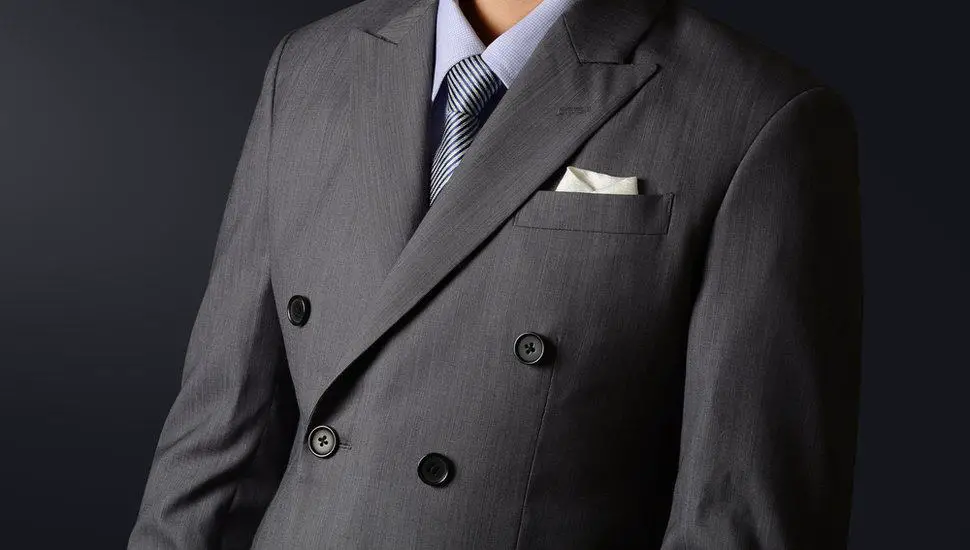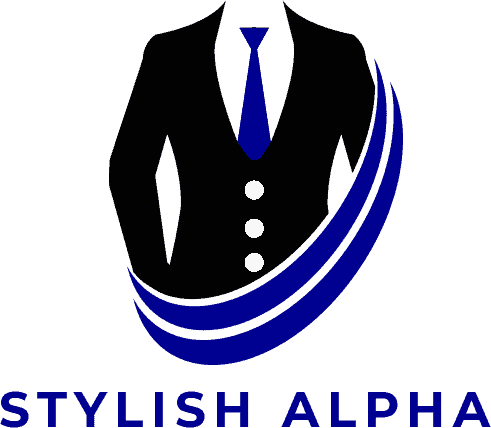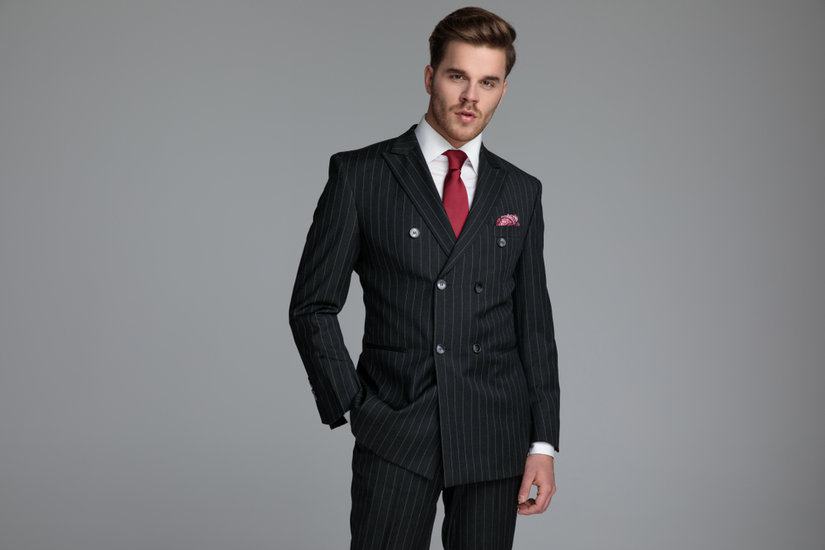A double breasted suit stands out as a sartorial choice that confidently exudes a sense of elegance and authority. Characterized by its additional fabric that folds across the body and two symmetrical columns of buttons, it is a style that harkens back to a rich history within men’s fashion.
Unlike its single-breasted counterpart, which is considered standard for everyday wear, the double-breasted suit makes a statement with its distinctive and more formal appearance.

The fit and silhouette of a double-breasted suit are key in achieving its modern, polished look. Tailoring is crucial as a well-fitted suit accentuates the wearer’s physique while allowing for comfort and movement. Though historically popular, the resurgence of the double-breasted suit in contemporary fashion highlights its timeless charm and versatility in fabric choice, patterns, and color.
Key Takeaways on Double Breasted Suits
- A double-breasted suit is a formal and powerful fashion statement.
- Tailoring is essential for the perfect fit and silhouette of the suit.
- It offers versatility in fabric, colors, and patterns, and creates an elegant look.
See these other popular picks on this category:
- Is an Untucked Shirt Formal?
- The Ultimate Guide on How To Choose a Tie Pattern
- Is It Ok to Wear a Blazer With an Untucked Shirt?
- How to Wear a Velvet Blazer
History and Evolution
When I consider the sartorial elegance that double-breasted suits exude, I am reminded of their iconic status. The evolution of the double-breasted suit is as rich in history as the garment is in fabric.
Having military origins, with roots tracing back to the reefer jackets of British Royal Navy officers. These garments, designed for practicality, had a double row of buttons to offer protection against harsh weather.
In the late 1800s, double-breasted suits shifted from their naval utility to become a casual alternative to formal tailcoats. Influenced by naval reefer jackets, which are akin to modern pea coats, these suits were adopted for leisure and sports.
This move marked the ‘casualization’ of the double-breasted suit, allowing it to be more accessible and worn by a broader audience for various occasions.
The double-breasted suit has remained a timeless piece in menswear, undergoing numerous reinventions to adapt to changing fashion trends. Despite fluctuations in popularity, it maintains a distinctive style with its overlapping front flaps and two columns of buttons, a trademark look that’s both classic and contemporary.
During the 1930s to the 1950s, the suit’s popularity surged as it became synonymous with the glamour of Hollywood and the sharp tailoring of Savile Row. Since then, double-breasted suits have seen rises and falls in fashion.
However, their enduring appeal assures me of their steadfast position in men’s wardrobes, with modern adaptations making them as relevant today as ever.
Defining Features of a Double-Breasted Suit
When I describe a double-breasted suit, I emphasize its unique design which sets it apart from its single-breasted counterpart. The most striking feature is the front closure; double-breasted jackets have wide, overlapping flaps of fabric.
This overlap is fastened with two parallel columns of buttons, generally ranging from four to six in total, sometimes with decorative buttons as well.
Lapels on a double-breasted suit are typically peak or notch, with peak lapels being a common choice for their formality and the way they contribute to a suit’s authoritative look. These lapels on a double-breasted suit are often more pronounced and wider, accentuating the chest and shoulders.
The silhouette of a double-breasted suit is quite distinct. It creates a strong and commanding silhouette that can be more structured than the relaxed fit of some other styles. A well-tailored double-breasted suit should appear neatly cinched at the waist, offering a look that’s both classic and powerful.
When discussing the coat of a double-breasted suit, note that it’s designed to be worn buttoned up; it maintains its dapper appearance best this way, as the fabric and button placement create a natural taper and frame the wearer’s shape. The arrangement and style of the buttons also play a critical role in the formality and aesthetic of the suit.
Here’s a breakdown for quick reference:
- Front Closure: Wide overlapping fabric with two columns of buttons.
- Lapel Style: Typically peak or notch, with peak lapels adding formality.
- Silhouette: Structured and cinched at the waist for a commanding look.
- Button Arrangement: Generally 4 to 6 buttons, contributing to suit’s aesthetic.
Suit Fit and Silhouette
When selecting a double-breasted suit, my primary focus is on the fit and silhouette it creates. I understand that the construct of these suits inherently offers a distinct shape compared to single-breasted styles.
The fit should be impeccable, contouring close to my body without being restrictive, allowing for a full range of motion. Slim fit double-breasted suits are designed to provide a modern, sleek silhouette. They taper towards the waist, accentuating the chest and shoulders.
The size of a double-breasted suit is pivotal. An ill-fitting suit can appear bulky, so pay close attention to your measurements. Ensure the jacket’s shoulders lie flat, and the sleeve length ends just above the wrist, exposing a half-inch of shirt cuff.
Here’s what to always check for in a double-breasted suit fit:
- Shoulders: Seamless alignment with mine
- Chest: Enough room without excess fabric
- Waist: Defined silhouette while buttoned
- Sleeves: Appropriate length for arm exposure
Your posture benefits from the structured design of a double-breasted suit, as it naturally encourages individuals to stand taller and with confidence. When buttoned, the suit gives a symmetrical appearance, which enhances your presence and stature in any room you walk into.
In my experience, durability and comfort are equally important. I prefer suits with a refined cut that moves with my body, acknowledging the dynamics of my daily activities. The defining features like the peak lapels, and the row of buttons create an assertive, powerful silhouette that’s timeless.
Fabric and Patterns

When selecting a double-breasted suit, my choice in fabrics and patterns is crucial to its overall appeal and functionality. Wool is a popular fabric option due to its durability and elegance. Depending on the weight, wool can provide warmth in colder weather or breathability during warmer months.
For patterns, pinstripes are a classic choice that elongates silhouette, adding to the suit’s sharp aesthetics. These are perfect for creating a more formal look. Meanwhile, herringbone presents a subtle V-shaped weaving pattern, adding texture and depth to the suit without being overly bold.
Another exquisite pattern to opt for is the Prince of Wales check. It’s a complex pattern characterized by a mix of checks and overchecks; it’s a perfect blend of sophistication and style. This pattern is versatile enough to transition from business to casual settings, making my double-breasted suit more adaptable.
When choosing patterns, keep in mind that they can greatly influence the suit’s versatility and wearability. Solid colors are more flexible, while bold patterns might limit the suit’s pairing options.
Here’s a brief guide to the typical fabrics and patterns for a double-breasted suit:
Fabrics:
- Wool: Suits all climates and is a timeless choice.
- Synthetics: Often blended with wool for added durability.
Patterns
- Pinstripe: Vertical stripes for a traditional business look.
- Herringbone: A zigzag pattern that offers texture.
- Prince of Wales check: A check pattern for those who prefer a statement piece.
My advice is to consider the occasion and my personal style when choosing the fabric and pattern for my double-breasted suit. These elements are fundamental in ensuring the suit looks impeccable and serves its intended purpose.
Color and Styling
When selecting the color of a double-breasted suit, consider both the occasion and your style. Traditional colors like navy and gray are versatile and appropriate for a range of settings, from business to formal events. For a more daring look, I might choose a pinstripe pattern or a brighter color, though it’s essential to ensure the suit’s fit is impeccable to pull off bolder styles.
In terms of styling, the shirt and tie play a critical role. I prefer a crisp white shirt for a clean and classic look that allows more freedom in selecting my tie. A tie with a deep color contrasts well with the suit and can complement the overall appearance.
To add a touch of sophistication, I select a pocket square that coordinates with the tie, yet it’s important not to match the patterns exactly. The pocket square should add a pop of color or pattern that reflects my personal touch.
Here’s a quick rundown of my approach:
- Suit Colors: Choose navy or gray for versatility, or bold colors for impact.
- Shirt: Opt for a crisp white for a classic backdrop.
- Tie: Select contrasting colors for a striking look.
- Pocket Square: Coordinate, don’t match, and add personal flair.
Remember, the key to nailing the double-breasted suit is in the details and a confident personal expression.
Suit Jacket Versus Blazer
When discussing suit jackets, I’m referring to a tailored jacket that comes as part of a set, complete with matching trousers. Suit jackets are often more structured and formal in appearance.
In contrast, a blazer is a standalone piece—meaning it is not sold with matching pants. Blazers usually have a looser fit and are less formal, which means they can be paired with a variety of different trousers for different looks.
Double-breasted suit jackets and double-breasted blazers bring their own unique style to these categories. A double-breasted suit jacket is part of a suit and features asymmetrical front with two parallel columns of buttons. This style speaks to a more formal, polished appearance, making it appropriate for business meetings or formal events.
My blazers can also be double-breasted, which elevates their formality compared to the single-breasted variety. Despite this, they retain the versatility blazers are known for due to their separate nature. The double-breasted blazer can serve as a chic option for business-casual environments or semi-formal occasions.
Here’s a simple comparison:
| Feature | Suit Jacket | Blazer |
| Part of a set | Yes, with matching trousers | No, sold separately |
| Structure | More structured | Looser fit |
| Button Style | Can be single or double-breasted | Often has distinctive buttons, can be single or double-breasted |
| Formality | More formal, especially double-breasted styles | Less formal, slightly elevated in double-breasted versions |
In my experience, whether I opt for a suit jacket or a blazer largely depends on the context and level of formality required. If my aim is to convey a sense of professionalism and formality, I lean towards the suit jacket. For occasions that call for smart yet not completely formal attire, I find a blazer to be perfectly suitable.
Button Configuration and Lapels
When discussing the quintessential elements of a double-breasted suit, button configuration and lapels are critical topics. Double-breasted suits feature two parallel columns of buttons with the left side folding over the right—distinct from single-breasted suits that have just one row of buttons.
Typically, double-breasted jackets have one to four rows of buttons, of which only one or two rows are functional. I prefer to use horn buttons for a refined look. The common configurations I find are:
- 4×2: Four buttons in total, in two columns, with two functioning.
- 6×2: Six buttons, two columns, and two that fasten, which is quite a timeless style as noted by Bond Suits.
The lapels on double-breasted suits are predominantly peak lapels, contributing to a more formal aesthetic. It’s rare to find a shawl lapel on these suits, as peak lapels accentuate the chest and shoulders, providing a strong silhouette.
Regarding styling, the rule of thumb is to always fasten the middle or top set of buttons, depending on the configuration, and never the bottom ones. This ensures the jacket drapes correctly and maintains its structured design.
I emphasize always being aware of the balance between the lapel width and the button stance, as the two should complement each other to maintain symmetry and proportion on the wearer’s frame.
Tailoring and Customization
When creating double-breasted suit, precision in tailoring is my primary concern. The hallmark of a well-made double-breasted suit lies in its fit; it should appear as if it was crafted exclusively for me. To achieve this, I always recommend made-to-measure services, which provide a suit tailored to my personal measurements.
The process begins with an initial fitting, where my measurements are taken. During this stage, I have the opportunity to customize my suit. I focus on the choices that reflect my personal style, such as:
- Fabric selection
- Button configuration
- Lapel design
- Vent placement
Once my measurements and preferences are recorded, the suit construction begins. Made-to-measure ensures that the suit will fit my body uniquely, gracious to the numerous alterations made throughout the construction process.
After my suit is initially assembled, I attend a second fitting. It’s here that I scrutinize the fit and feel of the garment. Any additional alterations necessary to perfect the suit’s drape and contour are marked by the tailor. For double-breasted suits, critical areas often adjusted include:
- Chest and waist circumference for a sculpted fit
- Sleeve and trouser length for a clean break over shoes and cuffs
- Shoulder width to maintain a sharp, structured look
The result of this meticulous process is a double-breasted suit that feels custom made for me—because it is. The precision and personalization of made-to-measure tailoring leave me with a garment that not only elevates my wardrobe but also boosts my confidence whenever I wear it.
Occasions and Dress Code

When selecting an outfit, consider the double-breasted suit as a timeless piece that exudes formality and confidence. It’s not just any suit; it’s a statement. The structured design, with its overlapping front and parallel rows of buttons, makes it a distinctive choice for various occasions. Below, I detail where and how this style fits into different dress codes.
Weddings:
For weddings, a double-breasted suit offers a sharp look. Opt for a classic navy or charcoal for a traditional ceremony, or a lighter shade for a summer wedding. The elegance of the double-breasted suit makes it perfectly appropriate for wedding attire, especially when aiming for a formal or semi-formal ensemble.
Office:
The office environment typically embraces a range of dress codes, from business casual to business formal. A double-breasted suit, thanks to its inherent formality, is well-suited for important meetings or high-profile office events. I recommend choosing subtle patterns or solid colors to maintain a professional appearance.
Formality:
Double-breasted suits exude a higher level of formality compared to their single-breasted counterparts. They are traditionally worn in more formal settings. However, modern sartorial rules allow for more flexibility. Pairing the suit with a roll-neck sweater or a casual shirt can dress it down, making it appropriate for less formal events while still maintaining a smart look.
When wearing a double-breasted suit, ensure to keep it buttoned up to maintain its sleek silhouette—it’s part of the suit’s character and charm. Whether at a wedding, at the office, or attending a gala, the double-breasted suit is a key player in the wardrobe, capable of adapting to various levels of dress codes while always keeping me looking my best.
Branding and Designer Suits

Certain brands stand out for their craftsmanship and style. Designer suits often carry a certain prestige, owing to their quality, fit, and the heritage of their labels.
One name that’s synonymous with American luxury is Ralph Lauren. Their suits are recognized for their timeless elegance and premium materials. Their double-breasted suits often feature sharp tailoring and a classic aesthetic, ideal for those looking to invest in a long-lasting wardrobe staple.
Across the Atlantic, Reiss offers modern takes on the double-breasted suit. Their designs frequently incorporate contemporary styles with slim fits, appealing to those looking to make a sartorial statement while maintaining an air of professionalism.
Comparatively, J.Crew provides accessible luxury with a pretty versatile range. Their suits can transition seamlessly from office attire to evening wear, making them a favorite for those who value both function and form.
In my experience exploring the intricacies of tailored suits, the Oliver Wicks team provides personalized attention to detail. Their commitment to quality is evident in their double-breasted suits, which are often made from luxurious Italian fabrics, ensuring both comfort and durability.
Discussing an Italian double-breasted suit brings to mind the artistry of well-established Italian tailoring traditions. Known for their flair and impeccable fit, these suits stand as a testament to the adage that a well-made suit can make the man.
Here’s a brief overview highlighting the specialty of each brand:
- Ralph Lauren: Classic American luxury with timeless appeal
- Reiss: Contemporary styles for the modern professional
- J.Crew: Versatile, accessible luxury for various occasions
- Oliver Wicks: Personalized suits with Italian craftsmanship
Choosing the right brand ultimately depends on your style preferences and the specific sartorial message you wish to convey.
Shopping and Care Tips
When shopping for a double-breasted suit, the main focus is on fit and quality, which often correlate with price. Look for a suit that creates a sharp silhouette, with a jacket designed to be buttoned up.
A well-fitted double-breasted suit should be close to the torso with higher armholes and trim sleeves. For a balance between budget and luxe, consider mid-range brands that offer a good balance of quality and cost.
Budget-Friendly Tip:
You don’t have to break the bank for a double-breasted suit; some retailers offer stylish options that don’t sacrifice too much on quality. Always check for sales or discount vouchers.
When it comes to care, a double-breasted suit requires attention to maintain its allure. Here’s how to ensure its longevity in your wardrobe:
- Rotation: Avoid wearing the same suit too often to prevent early wear and tear.
- Cleaning: Dry-clean sparingly to maintain the suit’s fabric integrity.
- Storage: Use a sturdy hanger to preserve the suit’s shape and store it in a garment bag to protect against dust.
Quality Over Quantity:
Even though a higher price tag might initially deter me, investing in one or two premium double-breasted suits can provide better value over time than purchasing several lower-quality ones.
| Shopping Must-Do’s | Care Best Practices |
| Fit is paramount: try it on! | Rotate suits between wearings. |
| Balance budget and quality. | Dry-clean only when necessary. |
| Opt for timeless over trendy. | Use proper hangers for storage. |
I’ve learned from my own experience that a double-breasted suit is a statement piece, so investing in and caring for this style pays off, ensuring I always look sharp and classic.
Frequently Asked Questions

In this section, I’ll address some common queries regarding double-breasted suits to clarify how they differ from single-breasted suits and the etiquette surrounding their wear.
How do the button rules differ for double-breasted suits compared to single-breasted suits?
Double-breasted suits usually feature two rows of buttons with only one or two rows being functional. Unlike single-breasted suits, where you might unbutton whilst sitting, the etiquette for double-breasted suits encourages keeping all the functional buttons fastened, even when seated.
What distinguishes a double-breasted tuxedo from a standard tuxedo?
A double-breasted tuxedo has overlapping front flaps with two symmetrical rows of buttons, offering a more pronounced V-shape and a distinctively formal appearance compared to the streamlined front of a standard tuxedo.
Can a black double-breasted suit be worn for all types of formal events?
While a black double-breasted suit is suitable for many formal events, the level of formality may vary. It is traditionally reserved for more solemn or upscale occasions where the dress code is explicitly stated or traditionally understood.
What are the style implications of wearing a double-breasted suit?
Wearing a double-breasted suit generally conveys a sense of formality and sophistication. Its structured silhouette and pronounced peak lapels can enhance a person’s presence, making it a bold fashion statement.
In what situations is wearing a double-breasted suit considered appropriate?
Double-breasted suits are appropriate for formal business settings, high-end social gatherings, and traditional events. They are less common in casual or laid-back environments where the attire is expected to be relaxed.
What is the main difference between a double-breasted and a single-breasted suit?
The main difference lies in the construction: a double-breasted suit features a wider overlap of fabric with two columns of buttons, providing a more formal and distinctive look compared to the single column of buttons on a single-breasted suit.

Samoel Ovanessian is the founder and creator of StylishAlpha.com – a website dedicated to men’s fashion. As a proud owner of more than 200 ties, he loves digging through new clothing combinations for everyday use, formal events and even just for fun. You can read more about Samoel here.

